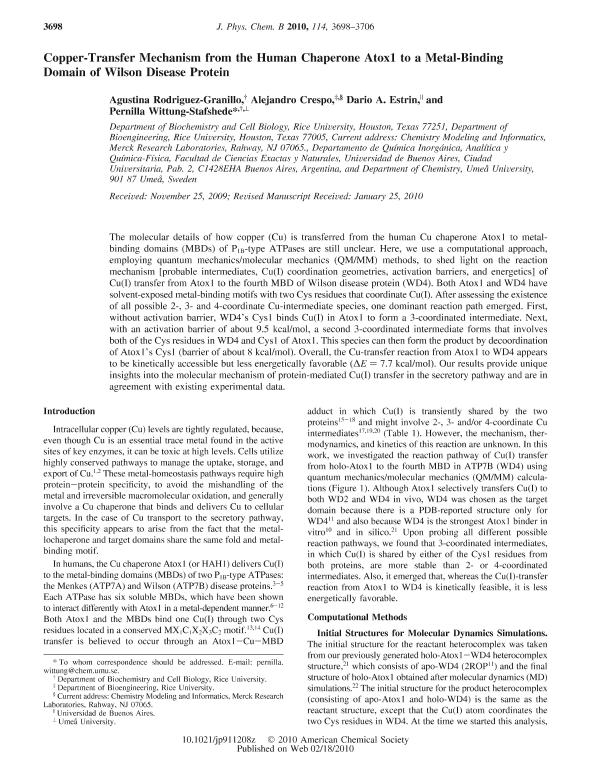Mostrar el registro sencillo del ítem
dc.contributor.author
Rodriguez-Granillo, Agustina
dc.contributor.author
Crespo, Alejandro

dc.contributor.author
Estrin, Dario Ariel

dc.contributor.author
Wittung-Stafshede, Pernilla
dc.date.available
2019-03-18T21:07:21Z
dc.date.issued
2010-03
dc.identifier.citation
Rodriguez-Granillo, Agustina; Crespo, Alejandro; Estrin, Dario Ariel; Wittung-Stafshede, Pernilla; Copper-transfer mechanism from the human chaperone Atox1 to a metal-binding domain of wilson disease protein; American Chemical Society; Journal of Physical Chemistry B; 114; 10; 3-2010; 3698-3706
dc.identifier.issn
1520-6106
dc.identifier.uri
http://hdl.handle.net/11336/71960
dc.description.abstract
The molecular details of how copper (Cu) is transferred from the human Cu chaperone Atox1 to metalbinding domains (MBDs) of P1B-type ATPases are still unclear. Here, we use a computational approach, employing quantum mechanics/molecular mechanics (QM/MM) methods, to shed light on the reaction mechanism [probable intermediates, Cu(I) coordination geometries, activation barriers, and energetics] of Cu(I) transfer from Atox1 to the fourth MBD of Wilson disease protein (WD4). Both Atox1 and WD4 have solvent-exposed metal-binding motifs with two Cys residues that coordinate Cu(I). After assessing the existence of all possible 2-, 3- and 4-coordinate Cu-intermediate species, one dominant reaction path emerged. First, without activation barrier, WD4's Cys1 binds Cu(I) in Atox1 to form a 3-coordinated intermediate. Next, with an activation barrier of about 9.5 kcal/mol, a second 3-coordinated intermediate forms that involves both of the Cys residues in WD4 and Cys1 of Atox1. This species can then form the product by decoordination of Atox1's Cys1 (barrier of about 8 kcal/mol). Overall, the Cu-transfer reaction from Atox1 to WD4 appears to be kinetically accessible but less energetically favorable (△E = 7.7 kcal/mol). Our results provide unique insights into the molecular mechanism of protein-mediated Cu(I) transfer in the secretory pathway and are in agreement with existing experimental data. © 2010 American Chemical Society.
dc.format
application/pdf
dc.language.iso
eng
dc.publisher
American Chemical Society

dc.rights
info:eu-repo/semantics/openAccess
dc.rights.uri
https://creativecommons.org/licenses/by-nc-sa/2.5/ar/
dc.subject
Chaperon
dc.subject
Atox1
dc.subject.classification
Otras Ciencias Químicas

dc.subject.classification
Ciencias Químicas

dc.subject.classification
CIENCIAS NATURALES Y EXACTAS

dc.title
Copper-transfer mechanism from the human chaperone Atox1 to a metal-binding domain of wilson disease protein
dc.type
info:eu-repo/semantics/article
dc.type
info:ar-repo/semantics/artículo
dc.type
info:eu-repo/semantics/publishedVersion
dc.date.updated
2019-03-08T20:18:53Z
dc.journal.volume
114
dc.journal.number
10
dc.journal.pagination
3698-3706
dc.journal.pais
Estados Unidos

dc.journal.ciudad
Columbus
dc.description.fil
Fil: Rodriguez-Granillo, Agustina. Rice Universite; Estados Unidos
dc.description.fil
Fil: Crespo, Alejandro. Consejo Nacional de Investigaciones Científicas y Técnicas; Argentina. Rice Universite; Estados Unidos. Merck Research Laboratories; Estados Unidos
dc.description.fil
Fil: Estrin, Dario Ariel. Consejo Nacional de Investigaciones Científicas y Técnicas; Argentina. Facultad de Ciencias Exactas y Naturales; Argentina
dc.description.fil
Fil: Wittung-Stafshede, Pernilla. Rice University; Estados Unidos. Universidad de Umea; Suecia
dc.journal.title
Journal of Physical Chemistry B

dc.relation.alternativeid
info:eu-repo/semantics/altIdentifier/url/https://pubs.acs.org/doi/abs/10.1021/jp911208z
dc.relation.alternativeid
info:eu-repo/semantics/altIdentifier/doi/http://dx.doi.org/10.1021/jp911208z
Archivos asociados
